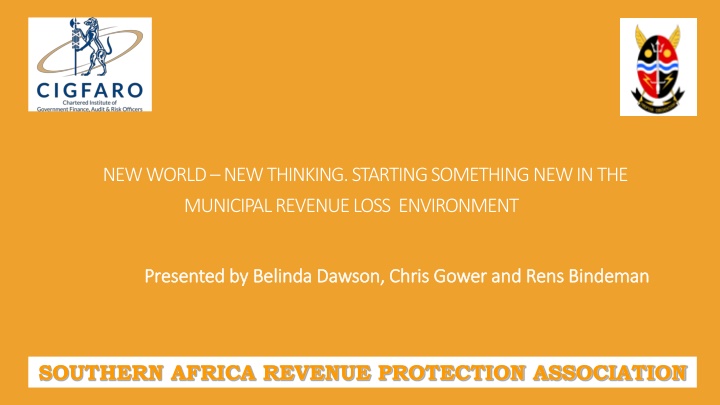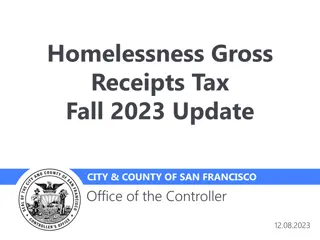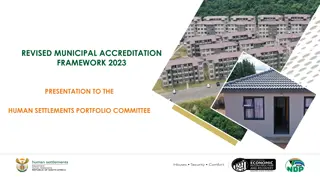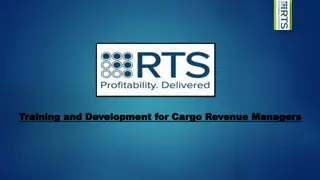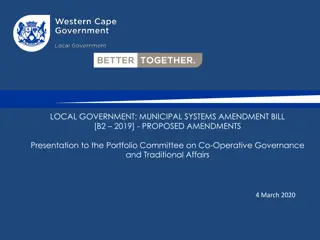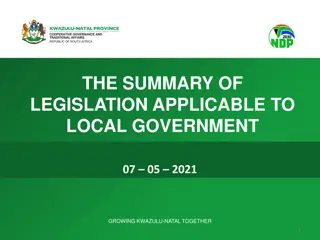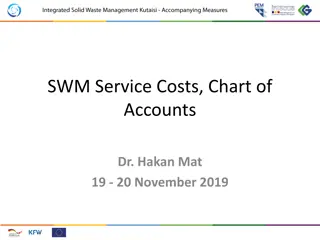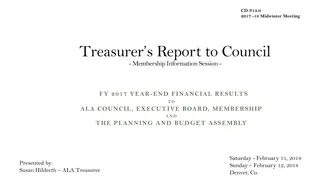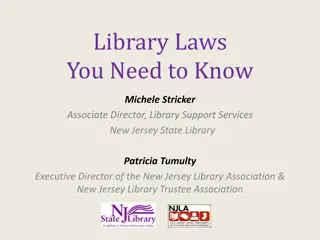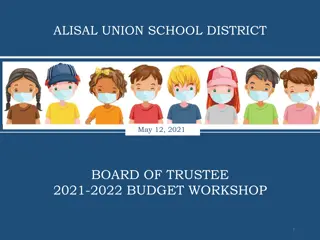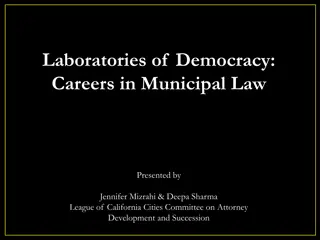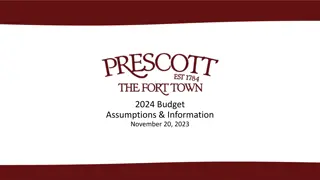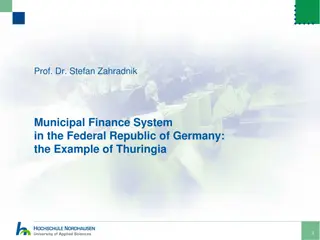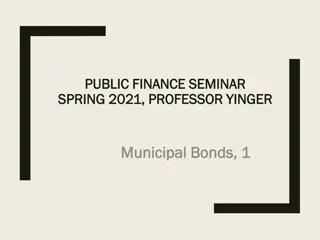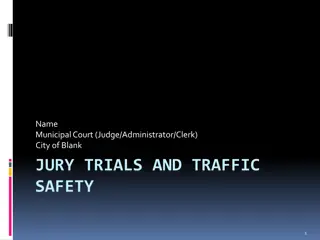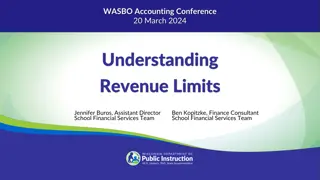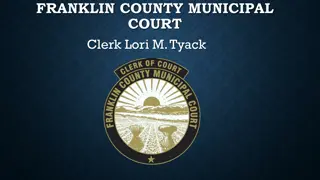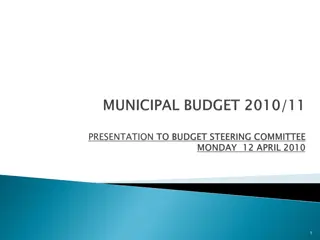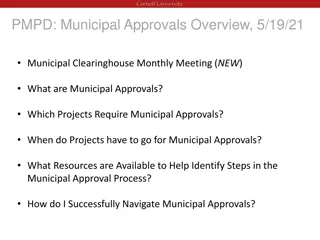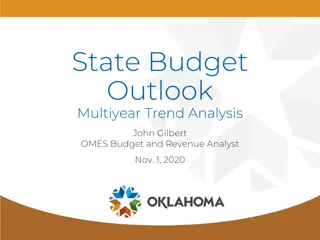New Thinking in Municipal Revenue Loss Environment
Presented by Belinda Dawson, Chris Gower, and Rens Bindeman of the Southern Africa Revenue Protection Association (SARPA), this initiative focuses on minimizing revenue losses and promoting solutions in utilities to combat pilfering and misappropriation. SARPA offers training courses, revenue recovery surveys, and membership services aimed at enhancing revenue protection knowledge and sharing industry best practices.
Download Presentation

Please find below an Image/Link to download the presentation.
The content on the website is provided AS IS for your information and personal use only. It may not be sold, licensed, or shared on other websites without obtaining consent from the author.If you encounter any issues during the download, it is possible that the publisher has removed the file from their server.
You are allowed to download the files provided on this website for personal or commercial use, subject to the condition that they are used lawfully. All files are the property of their respective owners.
The content on the website is provided AS IS for your information and personal use only. It may not be sold, licensed, or shared on other websites without obtaining consent from the author.
E N D
Presentation Transcript
NEW WORLD NEW THINKING. STARTING SOMETHING NEW IN THE MUNICIPAL REVENUE LOSS ENVIRONMENT Presented by Belinda Dawson, Chris Gower and Rens Bindeman Presented by Belinda Dawson, Chris Gower and Rens Bindeman SOUTHERN AFRICA REVENUE PROTECTION ASSOCIATION
CONTENTS 1. INTRODUCTION TO SARPA AND PROCESSES Belinda Marais (SARPA President) 2. REVENUE PROTECTION AND THE REDUCTION OF LOSSES Rens Bindeman (SARPA Technical Adviser) 3. INDEPENDENT POWER PRODUCERS (IPP) AND TARIFFS Chris Gower (Buffalo City) SOUTHERN AFRICA REVENUE PROTECTION ASSOCIATION
INTRODUCTION TO SARPA 1. SARPA s goal is to assist members to minimize losses and recover loss revenue by promoting the exchange of information and finding of solutions 2. Founded in 1997 by Utilities and Associations in South Africa, SARPA promotes the exchange of information and finding of solutions in protecting the income and assets of utilities against pilfering, misapplication and misappropriation. 3. The Association has nine regional branches in Gauteng, Limpopo, KwaZulu Natal, Western Cape, Eastern Cape, Freestate, Northern Cape, Mpumalanga and Namibia. 4. Membership is made up of utilities involved in the supply of electricity, water gas as well as contractors, manufacturers and consultants involved in the field of revenue protection and infrastructure related crimes. SOUTHERN AFRICA REVENUE PROTECTION ASSOCIATION
Projects Training SARPA provides training courses, masterclasses and workshops aimed at developing Revenue Protection knowledge. The seven training courses available are based on our internally developed curricula, which are updated regularly from best practices and can also be customized to fit specific needs. Members pay a reduced rate for such training events. For more information visit the SARPA web page www.sarpa.co.za. www.sarpa.co.za. Revenue Recovery Survey The revenue protection survey is a special exercise conducted by industry experts with the aid of the SARPA Revenue Recovery Toolkit , to identify the gaps and reasons for revenue losses and propose a turn- around plan.
Membership Services SARPA provides knowledge sharing events with its members which includes an annual Conventions, monthly Branch meetings and quarterly webinars Guidance is also provided to members organizations and its personnel regarding the different operational processes, best practices, risks and challenges Membership also ensures access to knowledge regarding all revenue protection standards and participation in standardisation development processes The SARPA Communication Strategy provides electronic feedback to members on various social media platforms featuring industry news, best practices and innovations relevant to the revenue protection industry
INTRODUCTION The entire Revenue Protection concept has developed in the past 20 years and has now reached a new level of expertise, which has resulted in the need for those involved in such actions to go to the next level of specialization and technology This has come about due to the fast tracking of the technology development process and the pandemic. This has triggered the Service providers to capture the market and offer all kind of packages and solutions.
WHO SHOULD BE RESPONSIBLE Revenue Protection is not solely a Finance function nor a Technical function For Municipalities to minimize losses, all Municipalities needs a Revenue Protection Champion who can operate all over the different Departments of a Municipality and not only in one Department.
SCENARIO 1. A premise had a zero consumption on their conventional meter. 2. On visit it was seen that the single-phase conventional meter was upgraded to a three- phase conventional meter 3. However, the single phase was disconnected, and the three-phase moved to the entrance 4. The meter reader kept on reading the single phase and was not aware of the three phase and that was caused by some miscommunication. 5. On inspection it came out that the tariffs are not correct, because on the wall it said Guest house and has 3 x 80A circuit breakers. So that means business tariff and not residential 6. It would need a suitable rates valuation and building plan and further investigation 7. Currently we have a basic fee along with a fixed fee on Residential sewerage, with an additional fee per connection on sewerage for business.
Difference between business and residential ACCOUNT RESIDENTIAL RATE BUSSINESS DIFFERENCE 0,005361 0,007702BUSSINESS LESS RESIDENTIAL VALUATION AMOUNT R 2 789 000,00 Rates R 14 951,83 R 21 480,88 R 1 245,99 R 1 790,07 Cost of Rates R 1 245,99 R 1 790,07 R 544,09 Sewerage R 285,41 R 472,89 R 187,48 Water*based on average R 2 212,13 R 1 241,32 R -970,80 Electricity*base on average R 6 086,19 R 5 673,02 R -413,17 Refuse R 160,17 R 160,17 R - TOTALS R 9 989,88 R 9 337,48 R -652,40 Difference R 652,40
Difference between business and residential Difference between business and residential - - Valuations Valuations ACCOUNT ACCOUNT RESIDENTIAL RATE RESIDENTIAL RATE DIFFERENCE DIFFERENCE 0,005361 0,007702 BUSSINESS LESS RESIDENTIAL VALUATION AMOUNT R 2 789 000,00 Rates R 14 951,83 R 1 245,99 R 21 480,88 R 1 790,07 Cost of Rates R 1 245,99 R 1 790,07 R 544,09 Sewerage R 285,41 R 472,89 R 187,48 Water*based on average R 2 212,13 R 1 241,32 R -970,80 Electricity*base on average R 6 086,19 R 5 673,02 R -413,17 Refuse R 160,17 R 160,17 R - TOTALS R 9 989,88 R 9 337,48 R -652,40 Difference R 652,40
Difference between business and residential Difference between business and residential Water Consumption Water Consumption WATER CONSUMPTION BUSSINESS RESIDENTIAL DES 2020 JAN 2021 FEB 2021 MRT 2021 APRIL 2021 MEI 2021 JUNIE 2021 JULIE 2021 AUG 2021 36 R 1 020,74 38 R 1 070,42 44 R 1 219,46 38 R 1 070,42 57 R 1 542,38 55 R 1 492,70 51 R 1 393,34 44 R 1 228,69 39 R 1 133,77 R 1 388,01 R 1 434,76 R 2 210,49 R 1 752,50 R 3 228,34 R 3 500,27 R 3 010,06 R 2 030,12 R 1 354,58 AVERAGE 44,67 R 1 241,32 R 2 212,13 Difference R 970,80
Difference between business and residential -Electricity ELECTRICITY CONSUMPTION BUSSINESS RESIDENTIAL DES 2020 30 R 5 506,29 R 5 715,32 JAN 30 R 5 818,10 R 6 113,61 FEB 30 R 5 506,74 R 5 715,32 MARCH 30 R 5 194,49 R 5 317,04 APRIL 30 R 6 127,80 R 6 509,20 MEI 30 R 5 632,70 R 5 876,79 JUNIE 30 R 5 725,40 R 5 995,20 JULIE 30 R 5 289,31 R 6 058,88 AUG 30 R 6 256,33 R 7 474,31 AVERAGE 30,00 R 5 673,02 R 6 086,19 Difference R 413,17
ASSUMPTIONS 1. Based on current valuation, it is more valuable for this guest house to make use of the business tariffs 2. Based on Water tariffs this guest house will pay more on the residential tariffs 3. Based on Electricity tariffs this guest house will pay more on the residential tariffs
TID ROLLOVER 1. Some Municipalities are issuing the tokens via the consumer whilst others are doing a full Revenue Protection function. 2. However, when doing this exercise, it will be beneficiary to the Municipality to follow a strict Revenue Protection Plan rather than only doing a TID rollover on the meter. 3. This will ensure income through proper Revenue Recovery. 4. Contractors and staffed used to do the rollover should be trained on Revenue Protection and be precise in the Revenue Protection Plan of the Municipality.
TID ROLLOVER By 24 November 2024, all STS Prepaid meters must have already received a new key change to program the meter on the new STS 6 version. Since the old STS system will not be able to create new tokens all Municipalities or other Utilities who did not engage in the upgrading of their STS system will not be able to receive any income from the sale of Prepaid Electricity.
Meter Management 1. Prepaid meters becomes faulty regularly. 2. Changing, packaging, cleaning and re-programming and testing of this alleged faulty meters are not cost-effective 3. Every year or three a new supplier wins the Tender. With PLC Prepaid the keypads are not universal and each supplier has its own. 4. Mostly the keypads goes faulty and stock management becomes a nightmare 5. Meters have become technically advanced and regular training is needed to ensure that meters are not removed unnecessarily.
REVENUE PROTECTION FOCUS AREAS 1. All actions should be to reduce losses 2. Data Driven Operations 3. Top Level Management support and involvement is very important, as Revenue Protection Officials need all the support they can get 4. Focus on Large Power Users first 5. Training of staff is seen as extremely important
SELF FUNDING INITIATIVE Experience has shown that Utilities who initiate dedicated Revenue Protection Sections soon find that these units become self-funding and within a period of as little as 2 2 years significant lost revenue for the Utility. years and can then can clawback Furthermore, one should not forget that audited and reinstated installations are once again the cash register of the utility that is generating revenue that was lost
FACTORS THAT IMPACT NON TECHNICAL LOSSES Influencing Influencing Factors Factors ILLEGAL CONSUMPTION ILLEGAL CONSUMPTION Illegal Illegal Connections Connections by by FRAUDULANT ACTS FRAUDULANT ACTS No revenue No revenue protection section protection section No budget No budget Lack of Lack of specialization specialization Lack of punitive Lack of punitive actions actions - - Bylaws Syndicate Syndicate activities activities Indigent tariff Indigent tariff Meter Meter Tampering Tampering Unknown Unknown Consumers Consumers ERRORS ERRORS Unsafe Leads Unsafe Leads Inaccurate Inaccurate recording of recording of consumption consumption Data fraud Data fraud Corruption Corruption Bylaws Inaccurate Inaccurate data data Ghost vending Ghost vending Rogue meters Rogue meters Metering Metering faults faults
LOSS REDUCTION MODELDiagra Revenue Protection & Loss Reduction Revenue Protection & Loss Reduction Capacity Building Training Data Analysis Field Audits Remedial Actions Revenue Recovery Illegal Detection Technology Split Metering AMR Meter Enclosures Smart Metering Technology Solutions Field Solutions E Engage and Educate ngage and Educate (Behaviour Change Interactions) (Behaviour Change Interactions)
IMPORTANT BEST PRACTICES 1. 1. Auditing of meters Auditing of meters 2. 2. Remedial Actions Remedial Actions 3. 3. Data Analysis Data Analysis 4. 4. Revenue Recovery Processes Revenue Recovery Processes 5. 5. MD Meter Recertification MD Meter Recertification 6. 6. Revenue Loss Forum Revenue Loss Forum
Rogue Meters A Rogue meter can be defined as a meter foreign to the utility fleet and which will be:- Not installed by the Utility or an Utility agent Installed as a check or sub vending meter Revenue does not go to the Utility Have a foreign Security Group Code (SGC) Have a foreign meter number sequence Was purchased from a non-Utility vendor
Scenario 2 Illegal connection in front of the Utility meter to sub vendor (seen as a bypass)
Scenario 3 - Replacing the Utility Meter with a non utility meter Utility meter discarded
SARPA TRAINING COURSES Courses was specifically designed to focus on electricity, water, finance and law enforcement issues Revenue Protection Basic Course Revenue Protection Management Course Revenue Protection Sensitizing Course Revenue Management Advance Course Revenue Protection Specialist masterclass Infrastructure Theft and Vandalism course Investigation skills development course SOUTHERN AFRICA REVENUE PROTECTION ASSOCIATION
NERSA LICENCE AGREEMENT PROPOSAL 6% of operational electricity income can be used to 6% of operational electricity income can be used to reduce technical losses but nothing for non reduce technical losses but nothing for non- - technical losses technical losses Municipalities must provide budget for Revenue Municipalities must provide budget for Revenue Protection activity to reduce non Protection activity to reduce non- -technical losses technical losses As it is not a license As it is not a license requirement,CFO s budget with reduced income and cash flow budget with reduced income and cash flow requirement,CFO s must provide must provide SARPA recommends that a minimum of 1 SARPA recommends that a minimum of 1- -2% of operational electricity income be used to fund operational electricity income be used to fund Revenue Protection operations until the National Revenue Protection operations until the National standard of 9% electricity losses is achieved standard of 9% electricity losses is achieved 2% of
THANK YOU SOUTHERN AFRICA REVENUE PROTECTION ASSOCIATION
